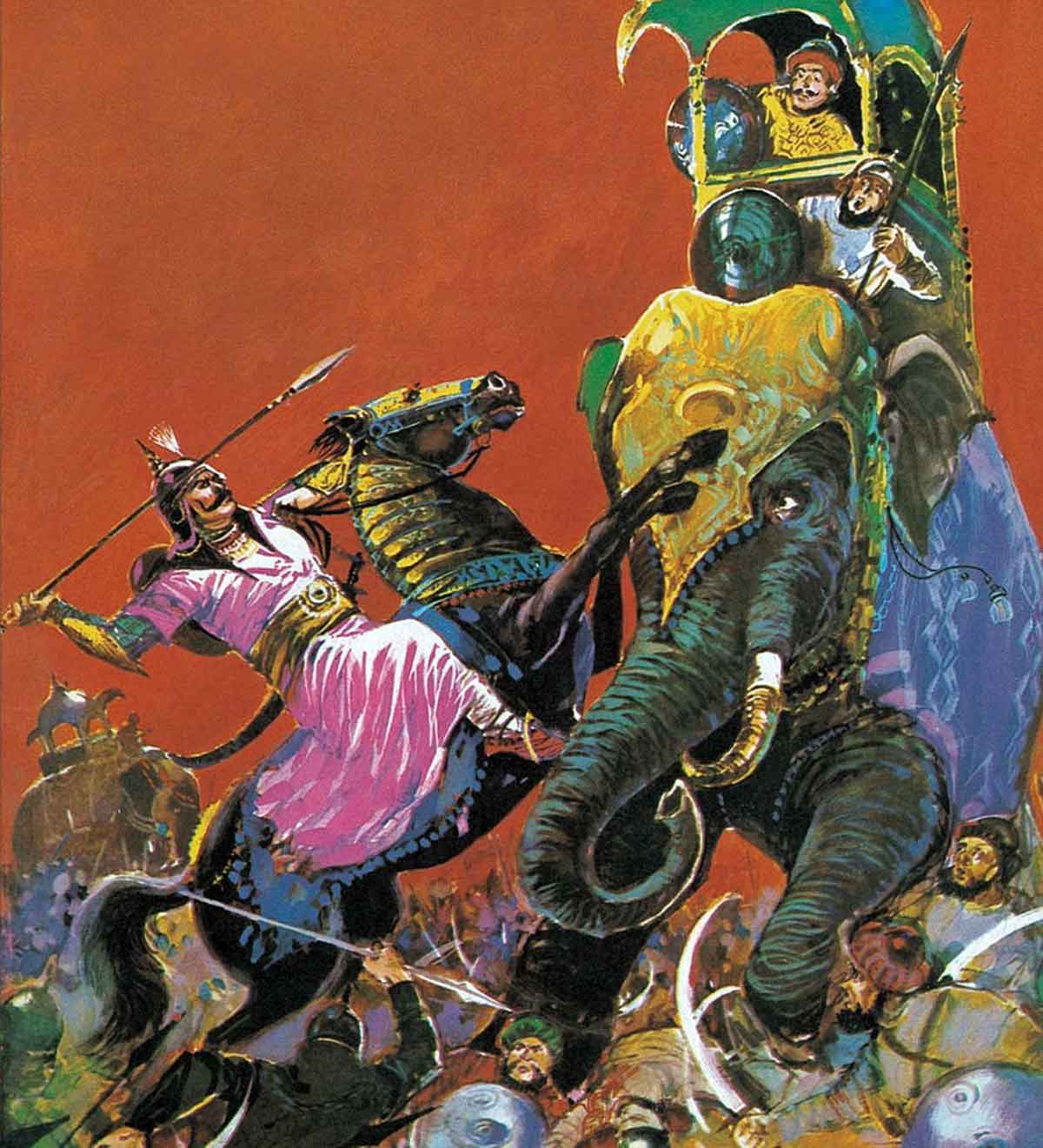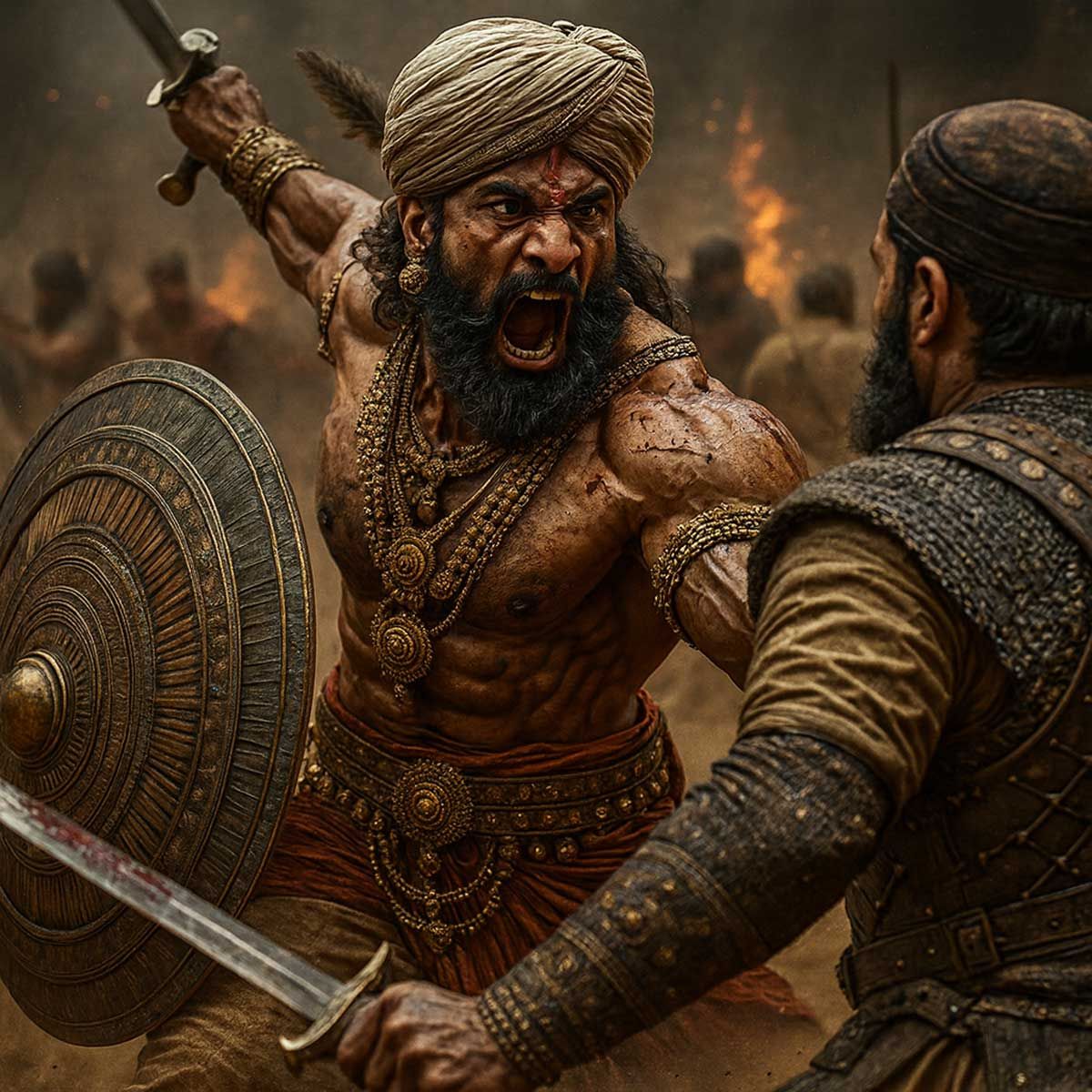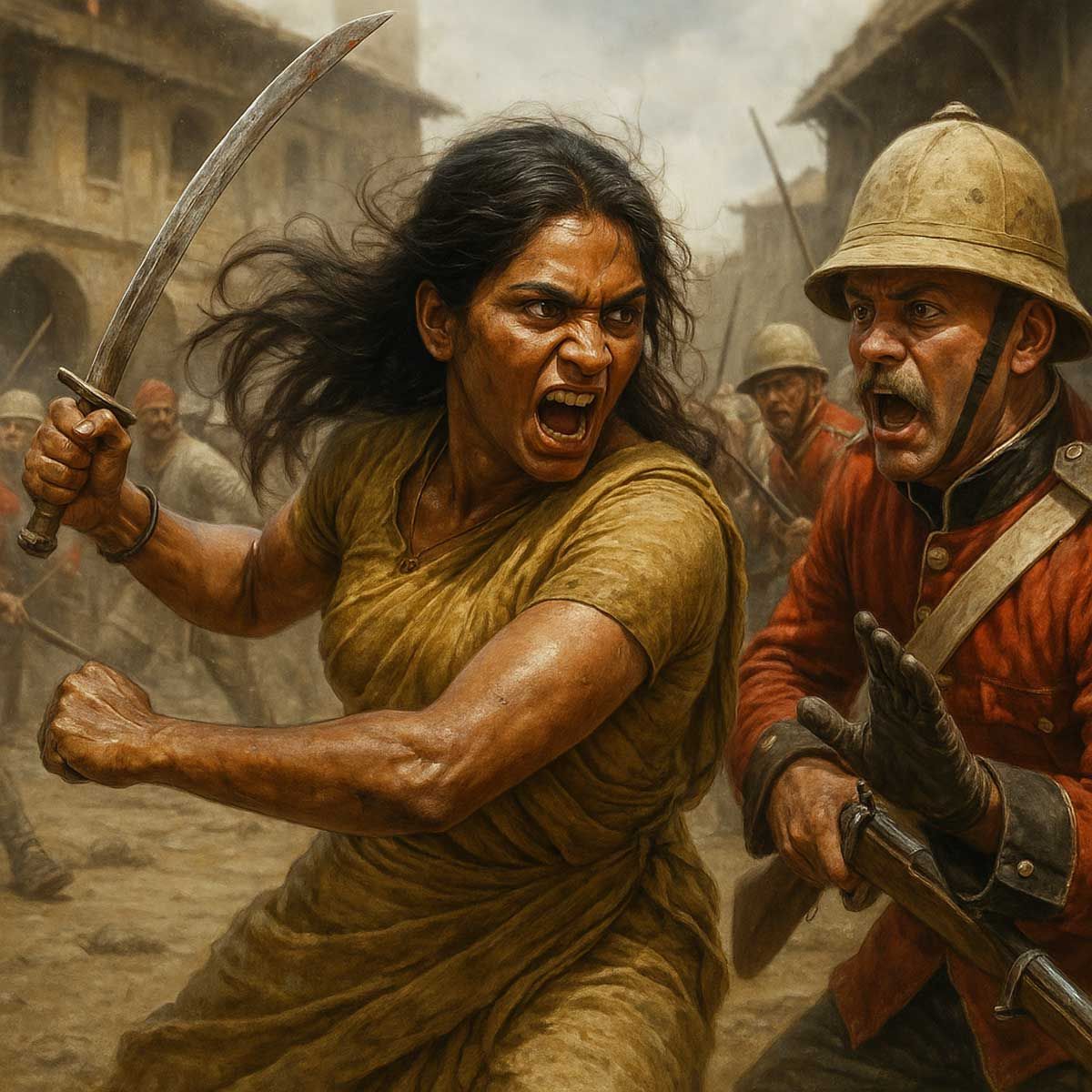More Coverage
Twitter Coverage
Satyaagrah
Written on
Satyaagrah
Written on
Satyaagrah
Written on
Satyaagrah
Written on
Satyaagrah
Written on
Join Satyaagrah Social Media
Rana Sanga, the symbol of bravery who defeated Sultan Ibrahim Lodhi and fought Muslim Terrorists for Hindu Existence

The desert land of Mewar has produced abundant warriors and their heroic legends. The fables of bravery are infused in this desert soil, every time a son of Mewar is born with his own tale to tell.
Rana Sanga! Indian history is full of acts of valor and daring glories. As we delve into the aspects of Indian history that has been kept out of reach of text books, we find many such unsung heroes whose bravery, magnanimity and courage made them look almost like super humans. It is a pity that our text books either make just a passing remark on such characters and acts, or just ignore them completely.
One such character was Maharana Sangram Singh aka Rana Sanga (14 April 1484 - 17 March 1527), the last ruler of medieval India who stood up against the muslim invaders and was able to unite many Hindu states to fight against the islamic foreigners. He was a Rajput in a true sense, a valiant fighter and a king who is legendary for his chivalry and generosity. Rana was the Rajput ruler of Mewar, which was located within the geographic boundaries of present-day India's modern state of Rajasthan. He ruled between 1508 and 1527.
Here, an effort has been made to look at a very important battle where Rana Sanga destroyed the Lodhi army of Delhi Sultanate and even captured a Lodhi prince. This particular battle was fought at Khatoli in the year 1518. Khatoli is a village near Harauti in Rajasthan.
 |
Rana Sanga had over 80 wounds all over his body and joints, was blinded in one eye by his brother, lost an arm by a sword cut against the Pashtuns of Delhi, and he limped because of an arrow wound in his leg which never recovered.
Family of Rana Sanga
Rana was born as a scion of the Sisodia clan of Suryavanshi Rajputs to Rana Rai Mal on 14 April 1484 at Malwa. Rana Sanga succeeded his father, as king of Mewar in 1508 and his successor was Ratan Singh II.
The name of his spouse was Rani Karnavati, who is also famous for her brave stint against foreign invaders and performs Jauhar (self-immolation) to protect her honour when the enemy was trying to capture her.
Rana Sanga was the grandfather of the famous King of Mewar Maharana Pratap, the fierce King of the Rajput dynasty. Rana Sanga had to go through a family battle to protect and siege his crown on Mewar state of Rajput’s.
Soon after his coronation, he united all the ethnic Indian kings without any barrier of religion and caste and persuaded them to fight against foreign invaders like Lodhi, Moguls, etc. Belonging to the legendary Sisodia clan of Rajputana lineage, he had the blood of fierce Rajput warrior.
After first ascending to the throne of his home kingdom, Mewar, then consolidating power there, Rana Sanga moved his army against the internally troubled neighbouring kingdom of Malwa.
Under the rule of Mehmod Khilji, Malwa was torn by dissension. Wary of his Rajput Wazir Medini Rai's power, the politically weak Mehmod sought outside assistance from both Sultan Ibrahim Lodi of Delhi and Bahadur Shah of Gujarat; whereas Rai, on his part, requested Sanga to come to his aid. Thus began the prolonged war between Mewar against the Muslim sultans of North India.
Joined by Rajput rebels from within Malwa, Sanga's troops from Mewar beat back invading armies from Delhi, ultimately defeating Malwa's army in a series of hotly contested battles. Khilji was himself taken prisoner, only to be freed after leaving his sons as hostages in Mewar's capital, Chittor. Through these events, Malwa fell under Rana’s military power.
Rana Sanga: Hindu Rajput Warrior’s Leadership Skills
Rana Sanga is remembered among historians as an able administrator, great visionary and a brave warrior – matchless traits indeed for a king of his time. The way he united the various factions of Rajputs under his able leadership was a tremendous act. After the death of Harsha Vardhan, Hindu Rajputs all over northern Bharat broke up into various factions squabbling and quarrelling among themselves which became the sole cause for the success of Muslim terrorists expansion in Bharat.
After few centuries, there was a king who was uniting the warring Hindu Rajput clans under Bhagwa dhwaj. After his initial success in battles against muslims, Rana Sanga became recognized within north India as a principal player in the fight against invaders to rule the northern territories of princely India. His objectives grew in scope – he planned to regain the much sought after prize of the muslim invasion of the time, Delhi, and bring the whole of India under his control to re-establish Hindu Rashtra.
He was a daring and courageous warrior who quickly started to expand his territories. This expansion brought him in direct conflict with the Lodhi dynasty of Delhi.
Sikander Lodhi had died in 1517 CE and his son Ibrahim Lodhi succeeded him. News of Rana Sanga extending his territories was a bad omen for the Delhi Sultanate, as Sanga’s extended territory almost touched the boundaries of Delhi. To wipe this threat of a resurging Hindu power, Ibrahim Lodhi decided to stop Rana in his tracks. He collected and organised a large army and started to move towards Mewar to intercept Rana Sanga.
 Ibrahim Lodhi |
Maharana Sanga decided to meet the foe head on and moved with his army. Both armies met face to face at Khatoli or Ghatoli village near the borders of Harauti. Ibrahim’s army was larger and better prepared in terms of numerical superiority and weapons. Rana Sanga and his army lacked it but they were motivated to the extent that they were ready to embrace death, fighting for the motherland. This is Kshatriya Dharma, where a warrior gets either victory or death with no other option.
Rana Sanga had an army mostly comprising of cavalry units from Mewar and Shekhawti. He also had a formidable infantry. Maharana decided to lead the army himself. His mere presence on the field was a great morale booster for his troops and tales of his daring and valor had already struck fear in his adversaries.Ibrahim was himself commanding the army seated on his favorite war elephant. He had heavy cavalry as well as a well trained and equipped infantry. He placed his infantry in the front and his heavy cavalry on the flanks. He himself along with a reserve force was at the back of his lines.
The battle started as a series of skirmishes between Lodhi horse and the Rajput horse. Rajputs had the upper hand in these skirmishes and they were repeatedly taunting the main lines of Sultan’s army. Ibrahim decided to put an end to this and ordered his lines to advance and engage the Rajputs in a full frontal attack.
Maharana Sanga quickly assessed the situation and ordered his heavy cavalry to form a spear head. He himself decided to lead the charge. His army was motivated to thrash the Sultanate’s army. Rajputs descended on the advancing Lodhi lines in a furious charge with Rana Sanga leading from the front. The impact and momentum of the charge was such that Lodhi army lines started to crumble and were scattered here and there. Lodhi cavalry quickly tried to counter the onslaught but the momentum of the charge was so intense that they were unable to withstand.
 |
Ibrahim decided to throw in his reserve in order to salvage the day. His reserve moved forward but their forward movement was hampered by routing Lodhi horsemen and infantry. The reserve of Lodhi army could not form a solid base against which they expected to turn the tables on Rajputs. A general and disorganised rout followed during which the Rajputs played havoc with the Lodhis. Ibrahim managed to run away but a royal prince of his family was caught. He was later released against payment of a hefty ransom.
In the words of a Lodhi era historian ‘Sultan’s armies scattered like dead leaves caught in a gale in front of Rajput cavalry charge’.
This battle lasted for around 5 hours. These 5 hours were a nightmare for the Lodhis which they could never forget. This battle crippled the Lodhi army to such an extent that they could not challenge Sanga again for a while. This battle also gave Mewar control over north eastern Rajasthan.
Rana Sanga was wounded in this battle but that did not deter his courage from taking part in further battles. He lost an arm by a sword cut and an arrow made him lame for life. He was already blind by one eye before his coronation.
|
There is an interesting incident which shows the greatness of Sanga. After this battle, Rana Sanga returned to Mewar. On the day he was to assume his duties by sitting on the throne, he surprised everyone by sitting instead on the ground among lesser nobles. The whole court was bewildered. They asked Rana the reason for such behavior to which he replied that ‘when a moorti of deity is broken in any form, it is not worshiped but instead kept outside the house and a new moorti is put in its place’. He said similar was his case as he had lost an arm and a leg so he should not continue as the Maharana. The whole court was stunned. Medini Rai, a Rajput chief took Rana Sanga by his hand and made him sit on the throne.
Battles Rana Fought
Rana Sanga fought nearly 100 big and small battles, including the battle of succession with his brothers. It was a written truth that he was never defeated but in his last battle against Babur.
The historians also suggest that if Babur had not accompanied Canons, the result of the battle was something else. Rana Sanga was become victorious in the battle against Babur and make history.
Of all the battles he fought below are some battles that change the course of history at those times and consider as essential battles of Rana Sanga and his kingdom.
- Battle of Khatoli
This fierce battle was fought in 1518 between Lodi dynasty under Ibrahim Lodi and the Kingdom of Mewar under Rana Sanga, the result of the battle was in favor of Rana Sanga, and Ibrahim Lodi lost a significant number of his men and armor.
- Battle of Dholpur
To avenge the loss of Khatoli, Ibrahim Lodi again united his army and men and prepared for the battle of Dholpur. Ibrahim Lodi was keen on taking avenge and gathered near Dholpur, as both armies met on the battlefield, and many soldiers from both sides touch the martyrdom. In last, Rana Sanga again emerges as victorious and defeat Ibrahim Lodi the second time.
- Battle of Gagron
To teach a lesson to Madini Rai, who start rebelling encroaching against Rana Sanga, Rana Sanga fought the Sultan in 1519, defeat him, capture him and treat him with honor during Sultan’s imprisonment.
- Battle of Ahmadabad
In 1520 Rana Sanga, with a coalition of Rajput armies, invade Gujarat and defeated Nizam Khan, the Sultan of Gujarat, flee to Muhammadabad.
 Battle of Khanwa |
- Battle of Khanwa
The last battle of Rana Sanga fought between Rajput forces led by Rana Sanga and Mogul Forces led by Mogul Emperor Babur. With the help of cannon and a large army, Babur won the battle, and the victory starts a new dynasty for Mogul Empire.
|
These are some essential battles fought by Rana Sanga, after the battle of Khanwa, he again prepares for avenge the loss and to take back his territory from Mogul, however, his chief who suppose that fought against Babur again was a suicidal attempt, so he poisoned Rana Sanga due to which Rana Sanga died on 30 January 1528.
There are many such stories from Indian history which are worth sharing and applauding. It is a pity that most of our young generation is totally unaware of their own roots. Or have they been kept unaware by design?
References:
indianrajputs.com
bharatstories.com - By Sakshi Jain
haribhakt.com
Saffron Swords: Centuries of Indic Resistance to Invaders - Manoshi Sinha Rawal, Yogaditya Singh Rawal
 Support Us
Support Us
Satyagraha was born from the heart of our land, with an undying aim to unveil the true essence of Bharat. It seeks to illuminate the hidden tales of our valiant freedom fighters and the rich chronicles that haven't yet sung their complete melody in the mainstream.
While platforms like NDTV and 'The Wire' effortlessly garner funds under the banner of safeguarding democracy, we at Satyagraha walk a different path. Our strength and resonance come from you. In this journey to weave a stronger Bharat, every little contribution amplifies our voice. Let's come together, contribute as you can, and champion the true spirit of our nation.
 |  |  |
| ICICI Bank of Satyaagrah | Razorpay Bank of Satyaagrah | PayPal Bank of Satyaagrah - For International Payments |
If all above doesn't work, then try the LINK below:
Please share the article on other platforms
DISCLAIMER: The author is solely responsible for the views expressed in this article. The author carries the responsibility for citing and/or licensing of images utilized within the text. The website also frequently uses non-commercial images for representational purposes only in line with the article. We are not responsible for the authenticity of such images. If some images have a copyright issue, we request the person/entity to contact us at This email address is being protected from spambots. You need JavaScript enabled to view it. and we will take the necessary actions to resolve the issue.
Related Articles
- Unsung Heroine Pritilata Waddedar, Who Shook The British Raj at the age of 21
- Kartar Singh Sarabha - The Freedom fighter who was Hanged at the age of 19 and inspired Bhagat Singh
- Tirot Singh: An Unsung Hero of the Khasi Tribe who destroyed British with his skill at Guerrilla Warfare
- Freedom struggle of Gurjars against Britishers at Koonja in 1824: 100s of Gurjars Martyred and 100s Hung in Single Tree
- Our first true war of independence lie forgotten within the fog of time and tomes of propaganda: Sanyasi Rebellion, when "renouncers of the material world" lead peasants in revolt against British and fundamentalist islamic clans
- 21-yr-old girl Bina Das shot Bengal Governor in her convocation programme at Calcutta University, got Padma Shri but died in penury
- 16 year old freedom fighter Shivdevi Tomar, who killed 17 Britishers and wounded many
- How Chhatrapati Shivaji Maharaj was establishing Hindu Samrajya by concluding centuries of Islamic oppression - Historian GB Mehandale destroys secular propaganda against Hindu Samrajya Divas
- Chronicles of Valour- The Battle of Haldighati
- "Purify your hearts with the water of love of motherland in national temple, and promise that millions will not remain untouchables, but brothers and sisters": Swami Shraddhanand, who awoke Hindu consciousness
- Dangers of losing our identity: Guru Tegh Bahadur forgotten and Aurangzeb being glorified
- Hindu Survival: What Is Needed To Be Done?
- Savitri Devi broke into tears when Yogi Adityanath decided to leave for Gorakhpur to take vow of sainthood, and today her eyes contain the same tears brimming with pride Yogi has emerged as a Chief Minister of Uttar Pradesh
- Martyrs’ march into the history - Rajguru: The Invincible Revolutionary
- The power of Sanatana Dharma and Fact Analysis of the Supernatural Fire Yogi of Tanjore
























